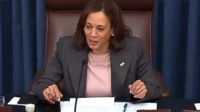At the international COP27 climate change conference in Sharm el Sheikh, Egypt on Nov. 11, President Joe Biden announced a U.S. Environmental Protection Agency proposal to toughen its U.S. methane emissions reduction rule—part of a larger global plan to address the greenhouse gas.
“We’re investing more than $20 billion in domestic methane mitigation to do things like cap orphan wells leaking methane, improving industrial equipment in the oil and gas sectors to reduce emissions,” he said.
EPA says if the strengthened proposal is finalized, it would cut methane emissions in the U.S. by 87% below 2005 levels.
The supplemental proposal reflects input and feedback from nearly half a million public comments to the proposal released in November 2021. It also is written to complement the recently enacted Inflation Reduction Act, which incentivizes and provides both technical assistance as well as financial resources for methane mitigation, detection and monitoring technologies.
“We’re listening to public feedback and strengthening our proposed oil and gas industry standards, which will enable innovative new technology to flourish while also protecting people and the planet,” EPA Administrator Michael Regan said in a statement.
The rule would apply primarily to the oil and gas industry, the largest emitter of methane in the U.S., and adds a “super-emitter response program” requiring operators to respond to credible third-party reports of high-volume methane leaks.
The supplemental proposal expands the entities and types of equipment that would be required to comply with the final rule’s requirements, such as currently-unregulated dry seal compressors, and sets a zero-emissions standard for pneumatic controllers and pneumatic pumps at oil and gas facilities. It would also require monitoring for emissions at abandoned or unplugged wells until all wells at a site are plugged and no fugitive emissions can be detected.
According to the American Petroleum Institute, the oil and gas industry reduced production-related emissions by 60% from 2011 to 2020 through voluntary efforts like The Environmental Partnership, which has more than 100 member firms from the the oil and gas sector.
The group “will continue to work with EPA in support of a final rule that is cost-effective, promotes innovation and creates the regulatory certainty needed for long-term planning,” said Frank Macchiarola, senior vice president of policy, economics and regulatory affairs
Gene Karpinski, president of the League of Conservation Voters, said in a statement that new provisions in the supplemental proposal that would "require monitoring at all well sites, address abandoned and improperly closed wells, and target super emitters,” reflect input from some communities most affected by oil and gas projects and infrastructure."
EPA will take comments on the final rule until Feb. 13, 2023, and plans to finalize it later in the year.
Also at the COP27 event, the UN Environment Programme launched a satellite-based system to "scale up global efforts to detect and act on major emissions sources," it said, noting the methane reduction agreement by nations at last year's climate change conference in Glasgow, Scotland.
The global Methane Alert and Response System (MARS), which will alert governments, companies and operators about large methane sources, will be the first publicly available to connect methane detection to notification processes. It will use data from global mapping satellites to identify very large methane plumes and hot spots and tap data from high-resolution satellites to link emissions to a specific source.
The UN said Its initial funding, which was not disclosed, came from the U.S. government, the European Commission and other sources.
"The world is far off track on efforts to limit global warming to 1.5°C,” said Inger Andersen, UNEP executive director. “Reducing methane emissions can make a big and rapid difference, as this gas leaves the atmosphere far quicker than carbon dioxide. [MARS] is a big step in helping governments and companies deliver on this important short-term climate goal.”






